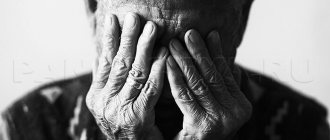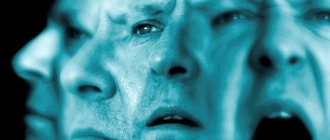Tremor is a fairly common disorder of motor function, the main symptoms of which are uncontrolled movements (shaking, vibration, trembling) of various parts of the body. The disease occurs as a result of constant involuntary muscle contractions, most often develops in older people, but can often affect adolescents. There are benign, postural and intention tremor.
Head tremor is characterized by “yes-yes” and “no-no” movements, manifests itself (intensifies) with severe excitement or at the time of drinking alcohol and is a sign of serious neuralgic disorders. Sometimes the disease is accompanied by trembling of the larynx and tongue, which causes speech impairment. The presence of tremor may indicate diseases such as Parkinson's disease, Wilson-Konovalov disease, mercury poisoning, kidney and liver failure. Symptoms of the disease vary in duration and severity.
Tremor
Tremor is a small shaking. It is usually one of the first symptoms to develop. Most often, one hand begins to tremble first. There may be specific finger movements, as if a person is rolling a pea. Gradually the tremor spreads to the other arm and legs. There may be a shaking of the head in a vertical or horizontal direction, such as nodding “yes-yes” or “no-no”. The eyelids and lower jaw may tremble separately. Very rarely, tremor covers the entire body.
Tremor is a small shaking. It is usually one of the first symptoms to develop. Most often, one hand begins to tremble first. There may be specific finger movements, as if a person is rolling a pea. Gradually the tremor spreads to the other arm and legs. There may be a shaking of the head in a vertical or horizontal direction, such as nodding “yes-yes” or “no-no”. The eyelids and lower jaw may tremble separately. Very rarely, tremor covers the entire body.
Parkinson's disease is characterized by tremors at rest. During movement, the trembling decreases, and during sleep it disappears altogether. But there are cases of intentional and postural tremor. Intentional is manifested by trembling, which occurs in the limb when it has already completed the movement it has begun. When you aim your finger at a target, at first everything is fine, but the closer you press, the more it trembles. Postural tremor occurs when it is necessary to maintain a static posture, such as holding your arms outstretched.
Types of head tics
Nervous tics in the head area are motor and vocal.
In the first case, this is the repetition of identical movements with the nose, lips, eyelids, and forehead. Vocal tics are obsessive snorting, hissing, coughing, sighing, and sniffling. The child can make vowel sounds and make short squeaks. Also, hyperkinesis (tics) in children are classified in medicine as local and multiple - a single muscle or several muscles are affected at once.
According to the initial state of the child’s nervous system, primary and secondary tics are distinguished. Primary is the only disorder, while secondary is provoked by existing brain dysfunction.
Muscle stiffness
Muscle stiffness and increased tone are also among the main symptoms of Parkinson's disease. This symptom even has its own term - plastic waxy flexibility. It is characterized by the fact that the limbs and body freeze in a given position. In this case, certain muscles suffer, and their stiffness leads to the formation of the so-called supplicant pose. The person slouches, his head leans forward, his arms are slightly bent at the elbow joints and pressed against the body, and his legs are bent at the hip and knee joints. If an outsider tries to straighten the patient’s limb, he will feel the kind of stepwise movements that are characteristic of gears in mechanisms. The phenomenon also got its name - the cogwheel symptom. Muscles lose the ability to return to their original position after performing an action. Therefore, patients may freeze in different positions for some time.
How to get rid of the disease
Alcohol tremors indicate a severe form of addiction. Therefore, it is important not only to eliminate the symptoms of the pathology, but also its cause.
Treatment at home with a doctor's call
To eliminate involuntary muscle contractions and avoid progression of the disorder to a generalized seizure, use:
- saline solutions, cocarboxylase, glucose;
- vitamins (necessarily thiamine, pyridoxine and cyanocobalamin);
- hepatoprotectors;
- means for activating cerebral and peripheral blood circulation, nootropic drugs;
- cardioprotectors;
- painkillers and antispasmodics.
Usually such treatment is sufficient to alleviate the patient's condition. If the tremor persists, the patient is additionally administered drugs from the group of benzodiazepines. They have a double effect: sedative and anticonvulsant.
Inpatient therapy
In any case, it is better to carry out detoxification in a clinical setting, but strict indications for hospitalization are:
- chronic diseases of the cardiovascular system;
- renal and/or liver failure;
- severe neurological pathologies (epilepsy, encephalopathy, recent stroke, history of neuroinfections, traumatic brain injuries);
- risk of developing a generalized seizure;
- signs of delirium, hallucinosis;
- use (in addition to alcohol) of drugs, strong sedatives.
In a hospital, the doctor has more opportunities to resolve the issue than to treat alcoholic tremors. The patient is under medical supervision at all times, basic vital parameters are monitored, and medications are administered almost around the clock.
In addition to medications, the clinic offers hardware detox procedures (ILBI, plasmapheresis). Excellent results are demonstrated by physiotherapy, laser or electromagnetic stimulation of biologically active zones on the body.
In a hospital, you can determine and how to treat the cause of alcoholic tremors - an uncontrollable desire to drink. After detoxification is completed, consultations with a psychotherapist begin, who motivates the patient to finally get rid of addiction.
How to treat the disease yourself
Doctors categorically warn against self-medication, taking any medications (and especially sedatives or anticonvulsants) without prior diagnosis and doctor’s prescriptions. But if for some reason the patient cannot go to a specialized hospital, doctors give several tips on how to alleviate their condition:
- completely eliminate alcohol;
- reconsider your diet and diet: you need to give up coffee, strong tea, and energy drinks;
- moderate physical activity is required (but not before bedtime);
- drink plenty of fluids (at least 1.5 liters of clean water per day);
- go to bed on time, before going to bed, avoid watching gadgets and movies - it is better to replace them with a walk in the fresh air.
But these are only temporary measures; final recovery from alcoholism requires complex long-term treatment and mandatory rehabilitation. But in parallel with addiction therapy, to eliminate alcoholic tremors, correction of concomitant neurological and metabolic disorders is also carried out.
Hypokinesia
Hypokinesia is a decrease in motor activity. General stiffness of movements is characteristic. In order to make any gesture, the patient must make an effort. Outwardly, it looks as if the movements are made after a pause, they are slow.
A person's gait changes. He moves in small mincing steps, with his feet parallel to each other. The arms do not move in time with the walking, but are pressed to the body. Facial expressions suffer. The face becomes motionless and impassive. The display of emotional reactions is delayed. Such people rarely even blink. The voice changes, it becomes monotonous and dull. If a person utters a long sentence or phrase, it fades towards the end.
Postural instability
Violation of postural fixation can occur in the early stages, for example, patients cannot hold their arms extended forward. But these are not such serious deviations that both patients and doctors pay attention to them. But closer to the later stages of the disease, serious problems begin. For example, there are difficulties with starting movement and stopping it, no matter how difficult it is to overcome the inertia of rest and movement. During movement, the body tilts along the course of inertia; in particular, when moving forward, it tilts and, as it were, moves ahead of the legs. This disrupts the center of gravity and leads to frequent falls and injuries.
Avoid risks
First of all, you need to lead a healthy lifestyle. No alcohol, drugs, or smoking. Follow a daily routine, try to sleep at least 9 hours.
Try to get as many pleasant emotions as possible. Contact a specialist at the slightest suspicion of illness.
There is no need to be ashamed of head tremors and try to hide this condition, it won’t work anyway. Don't hide from the problem, thinking that everything will go away on its own, it won't happen.
Sound the alarm at the slightest symptoms, consult a doctor and everything can still be improved for the better. Take care of yourself and be healthy!
Other symptoms of Parkinson's disease
In addition to movement disorders, Parkinson's disease may cause a lot of other symptoms, some of which lead to maladaptation and disability:
- Increased salivation.
- Mental disorders - depression, psychosis, dementia, insomnia, hallucinations. These manifestations can be associated with the disease itself, or occur as side effects from its treatment.
- A speech disorder associated with the impossibility of normal functioning of the muscles of the speech apparatus.
- Dysfunction of the pelvic organs.
- Weight changes - from emaciation to obesity.
- Increased greasiness of skin and hair.
Without treatment, the symptoms of Parkinson's disease steadily progress, and within 15 years of the onset of the disease, about 90% of patients have disability. But modern methods of therapy (medical and surgical) make it possible to keep the situation under control, increase life expectancy and improve its quality in people with such problems.
Gymnastics for essential tremor[edit | edit code]
Optimal suitable types of load[edit | edit code]
- yoga
- qigong
- tai chi
- Pilates
- training with weights and resistance on machines
- walking
- run
- swimming
- a ride on the bicycle
Essential tremor
- a condition caused by disturbances in the areas of the brain responsible for movement. As a result, the hands and head, and sometimes the arms and legs themselves, tremble when a person performs any action - writing, pouring liquid, shaving, etc. The tongue and jaw may also be affected, and the voice may tremble. This condition is not life-threatening, but many people find it extremely unpleasant, annoying and embarrassing. Trembling is especially aggravated by stress, anxiety, anger, physical exertion, caffeine, and certain medications.
Why train[edit | edit code]
An exercise program designed by a physical therapist can sometimes help reduce shaking and improve coordination and muscle control. Some patients find that exercise actually makes the cramps worse, but even so, your overall physical condition will improve. The tremors may become worse immediately after exercise, but they usually become less severe when the person is rested. Physical activity is a great way to relieve stress, reduce anxiety and improve self-esteem. Weight and resistance exercises that strengthen the arms can often reduce the magnitude of the tremors. Working out on machines is easier than trying to lift free weights or ride a real bike.
Yoga, tai chi and qigong will teach you how to relax and breathe correctly. Yoga will also strengthen your muscles, while qigong and tai chi will improve stability. The slow movements of tai chi and qigong help to release internal energy, qi. Many people have gotten rid of coordination disorders with their help. The type of yoga you prefer will depend on the severity of your symptoms. You may want to look into a program specific to people with a specific disability.
Confusion[edit | edit code]
Some people with essential tremor feel uncomfortable at the thought of exercising in front of everyone. If this bothers you, there is always the option of studying at home by purchasing a special training DVD. No matter which option you choose, be sure to practice. If you find the courage to walk, run, swim, or attend group fitness classes, you will avoid the feelings of isolation and despondency that often plague patients with this diagnosis. You will feel better if you open up to people. Explain to the instructor and other group members what is wrong with you. If you get tired, rest. Don't let embarrassment ruin your enjoyment of leading an active life. You have no less right to leave the house and take care of your health than anyone else.
Exercise strengthens your muscles, which helps reduce the range of tremors and improve your self-confidence.
How often?[edit | edit code]
- The effect of exercise on patients with this diagnosis varies in each case, as does the patient's ability to perform exercises and their duration.
- Fatigue causes tremors, so listen to your body. If today is not the best day, take a rest.
In general, plan at least 3 workouts of 30-60 minutes per week, or walk or run for at least 15 minutes 5 days a week. If you feel empowered to do more, do it.









